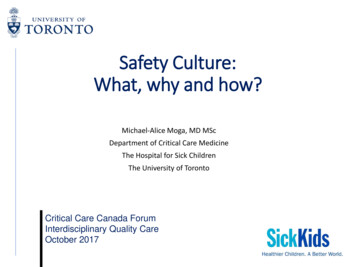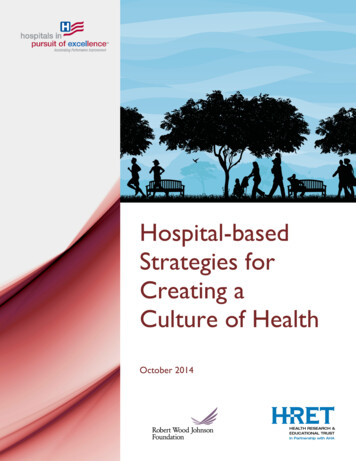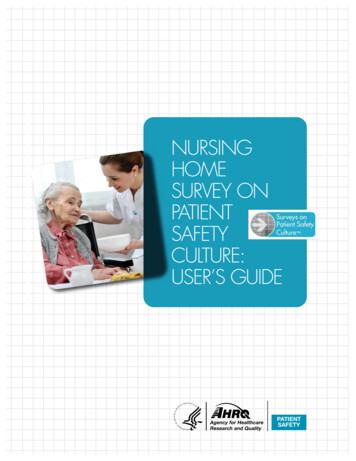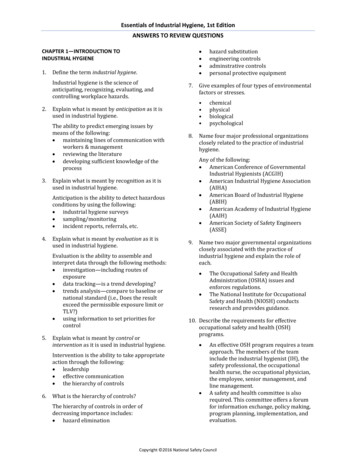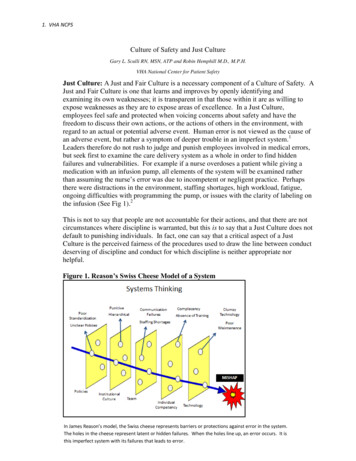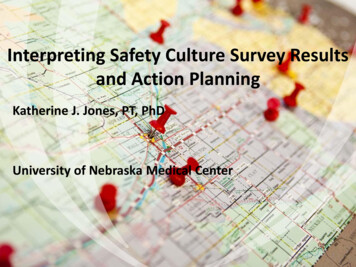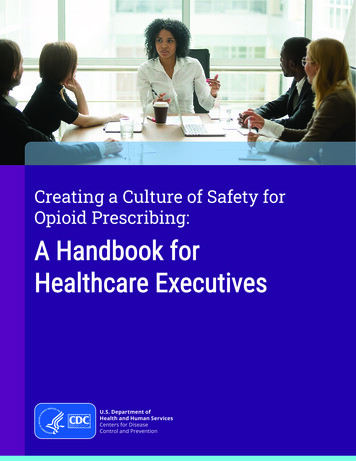
Transcription
Creating a Culture of Safety forOpioid Prescribing:A Handbook forHealthcare Executives
This handbook features insights andadvice from healthcare executives andquality improvement leaders from thefollowing health systems:Table of ContentsLetter from Dr. Grant Baldwin1The Value ofEvidence-Based Opioid Prescribing2Collecting and Using Data5Engaging with External Stakeholders8Establishing Policies and Standards thatSupport Safer Opioid Prescribing Practices10Training and Educating Providers13Supporting the Continuum of Care14Helpful Resources, Trainings, andTools Referenced in this Handbook16Montefiore Medical CenterBronx, New Yorkmontefiore.orgSt. Mary’s Hospital & ClinicsCottonwood, Idahosmh-cvh.orgAtrius HealthNewton, Massachusettswww.atriushealth.orgStormont Vail HealthTopeka, Kansasstormontvail.org
Letter From Dr. Grant BaldwinAs a healthcare executive, you’ve undoubtedly seen the devastating impactthat opioid overdose deaths and opioid use disorder have had in yourhealth system and in your community.Forty-one people die every day from overdoses involving prescriptionopioids. From 1999 to 2018, more than 232,000 people died in the UnitedStates from overdoses involving prescription opioids.In order to create health systems and communities that embrace saferopioid prescribing, multifaceted efforts and commitments are needed fromteams of dedicated interdisciplinary experts—both internal and external.Healthcare executives like you are critical to leading these efforts to cultivatea culture of safer opioid prescribing.In this handbook, you’ll find insights and advice from healthcareexecutives and quality improvement leaders from four different healthsystems representing urban, suburban and rural settings. They sharetheir experiences with engaging with internal and external stakeholders,working across interdisciplinary teams, leveraging data to inform efforts,implementing training and educational efforts, and much more. Alsoincluded is a list of resources, tools, and trainings that you and your teammay find helpful.We hope this handbook inspires and supports you and your teams’ ongoingefforts to improve patient outcomes, quality of care, and safety related toopioid prescribing. Thank you for your leadership in improving the health ofyour patients and your communities.Dr. Grant BaldwinDirector, Division of Overdose Prevention(DOP), National Center for InjuryPrevention and ControlCDC’s efforts to support safer opioidprescribingIn response to the critical need forconsistent and current opioid prescribingguidelines, the CDC released theGuideline for Prescribing Opioids forChronic Pain (CDC Guideline) in 2016.These recommendations focus on clinicalpractice and provide evidence andguidance to improve how these drugsare prescribed—and ultimately improvepatient care. CDC also launched anonline training series to help providersunderstand how to implement the CDCGuideline into clinical care. In addition,CDC developed the Quality Improvementand Care Coordination: Implementing theCDC Guideline for Prescribing Opioids forChronic Pain resource, which is intendedto help healthcare systems integratethe Guideline and associated qualityimprovement (QI) measures into theirclinical practice.1
The Value of Evidence-BasedOpioid PrescribingCDC released the CDC Guideline for Prescribing Opioids for Chronic Pain (CDC Guideline) in March 2016. The CDCGuideline offers recommendations about the appropriate prescribing of opioids to ensure patients who are 18 yearsand older have access to safer, more effective treatment for chronic pain (pain lasting longer than three monthsor past the time of normal tissue healing) outside of active cancer treatment, palliative care, and end-of-life care.Implementing evidence-based opioid prescribing practices that align with the CDC Guideline can significantlyimprove the safety of prescribing. It can also help reduce the harms associated with opioids, including opioid usedisorder (OUD) and overdose.The CDC Guideline provides 12 recommendations, grouped into three sections:Section 1: Determining When to Initiate or ContinueOpioids for Chronic Pain1Opioids are not the first line therapy.Nonpharmacologic therapy and nonopioid pharmacologic therapy are preferred for chronic pain. Providersshould consider opioid therapy only if expected benefits for both pain and function are anticipated tooutweigh risks to the patient. If opioids are used, they should be combined with nonpharmacologic therapyand nonopioid pharmacologic therapy, as appropriate.2Establish goals for pain and function.Before starting opioid therapy for chronic pain, providers should establish treatment goals with all patients,including realistic goals for pain and function and should consider how opioid therapy will be discontinued ifbenefits do not outweigh risks. Providers should continue opioid therapy only if there is clinically meaningfulimprovement in pain and function that outweighs risks to patient safety.3Discuss risk and benefits.Before starting and periodically during opioid therapy, providers should discuss with patients known risks andrealistic benefits of opioid therapy and patient and clinician responsibilities for managing therapy.“We’re adhering to our process measures— making sure thatpatients who have been on opioids long-term have a urinedrug screen, a treatment agreement, and that they’re seenat least two to four times per year. As a result, we’ve seen adecrease in opioid use among patients with chronic painand an increase in non-opioid therapies to treat pain moresafely and effectively. We’re also seeing improvements ininterdisciplinary collaboration among our staff, which helps usimprove our performance.“Thomas Isaac, MDSenior Medical Director of Quality,Safety, and Patient ExperienceAtrius Health2
Section 2: Opioid Selection, Dosage, Duration, Follow-Up,and Discontinuation4Use immediate-release opioids when starting.When starting opioid therapy for chronic pain, providers should prescribe immediate-release opioids instead ofextended-release/long-acting (ER/LA) opioids.5Use lowest effective dose.When opioids are started, providers should prescribe the lowest effective dosage. Providers should use cautionwhen prescribing opioids at any dosage, should carefully reassess evidence of individual benefits and riskswhen considering increasing dosage to 50 morphine milligram equivalents (MME) per day, and should avoidincreasing dosage to 90 MME per day or carefully justify a decision to titrate dosage to 90 MME per day.6Prescribe short-durations for acute pain.Long-term opioid use often begins with treatment of acute pain. When opioids are used for acute pain,providers should prescribe the lowest effective dose of immediate-release opioids and should prescribe nogreater quantity than needed for the expected duration of pain severe enough to require opioids. Three days orless will often be sufficient; more than seven days will rarely be needed.7Evaluate benefits and harms frequently.Providers should evaluate benefits and harms with patients within one to four weeks of starting opioid therapyfor chronic pain or of dose escalation. Providers should evaluate benefits and harms of continued therapy withpatients every three months or more frequently. If benefits do not outweigh harms of continued opioid therapy,providers should optimize other therapies and work with patients to taper opioids to lower dosages or to taperand discontinue opioids.Section 3: Assessing Risk and Addressing Harms ofOpioid Use8Use strategies to mitigate risk.Before starting and periodically during continuation of opioid therapy, providers should evaluate risk factorsfor opioid-related harms. Providers should incorporate into the management plan strategies to mitigate risk,including considering offering naloxone when factors that increase risk for opioid overdose, such as historyof overdose, history of substance use disorder, higher opioid dosages ( 50 MME per day), or concurrentbenzodiazepine use, are present.9Review prescription drug monitoring program (PDMP) data.Providers should review the patient’s history of controlled substance prescriptions using state prescription drugmonitoring program (PDMP) data to determine whether the patient is receiving opioid dosages or dangerouscombinations that put him or her at high risk for overdose. Providers should review PDMP data when startingopioid therapy for chronic pain and periodically during opioid therapy for chronic pain, ranging from everyprescription to every three months.3
10 Use urine drug testing.When prescribing opioids for chronic pain, providers should use urine drug testing before starting opioidtherapy and consider urine drug testing at least annually to assess for prescribed medications as well as othercontrolled prescription drugs and illicit drugs.11 Avoid concurrent opioid and benzodiazepine prescribing.Providers should avoid prescribing opioid pain medication and benzodiazepines concurrently wheneverpossible.12 Offer treatment for opioid use disorder.Providers should offer or arrange evidence-based treatment (usually medication-assisted treatment withbuprenorphine or methadone in combination with behavioral therapies) for patients with opioid use disorder.Quality Improvement and Care Coordination:Implementing the CDC Guideline for PrescribingOpioids for Chronic PainCDC developed the Quality Improvement and Care Coordination: Implementing the CDC Guideline for PrescribingOpioids for Chronic Pain resource, which is intended to help healthcare systems integrate the CDC Guideline andassociated quality improvement (QI) measures into their clinical practice. This resource offers primary care providers,practices, and healthcare systems a framework for managing patients who are on long-term opioid therapy.It offers 16 clinical QI opioid measures that align with the CDC Guideline recommendation statements, as well asguidance on operationalizing each QI measure to monitor progress.It also describes practice-level strategies to organize and improve the management and coordination of long-termopioid therapy, such as: Using an interdisciplinary team approach Establishing practice policies and standards Using electronic health record (EHR) data to develop patient registries and track QI measures“Since joining the CDC QI Collaborative, we have seen anoverall reduction in opioid prescribing. More importantly,we’ve focused on high-dose, high-risk, and unnecessary opioidprescribing. Critically, we have also enrolled more patients thanever in treatment for opioid use disorder.”Sharon Rikin, MD, MSDirector of AmbulatoryQuality ImprovementMontefiore Medical Center4
Consider augmenting your team’s training with these resources.Implementing CDC’s Opioid Prescribing Guideline into Clinical tingQuality Improvement (QI) and Care Coordination: Implementing the CDC Guideline for Prescribing Opioidsfor Chronic lPocket Guide: Tapering Opioids for Chronic Painwww.cdc.gov/drugoverdose/pdf/Clinical Pocket Guide Tapering-a.pdfHHS Guide for Clinicians on the Appropriate Dosage Reduction or Discontinuation of Long-Term Opioid 2019-10/8-Page%20version iscontinuation%20of%20Opioids.pdfCollecting and Using DataCollecting and using opioid prescribing and overdose data in your health system plays a crucial role in reducingpatient harm and improving outcomes by informing prevention and response efforts. Integrating routine checks ofthe prescription drug monitoring program (PDMP) into standard procedures has the potential to reduce patient riskby assessing for concurrent substance use or dangerous combinations that put patients at higher risk for opioid usedisorder and overdose.Sharing data can help health systems better anticipate education, treatment, and follow-up services needed tosupport patients. For example, sharing emergency department (ED) overdose data can inform a coordinatedcommunity response.Finally, data can inform public awareness campaigns to increase prevention efforts, promote treatment andrecovery, and reduce misuse and overdose. Here you’ll find insights and advice from health leaders on leveragingdata to inform safer prescribing practices:Putting Data to WorkA rise in opioid overdoses seen in the ED may indicate the need to provide more community-based drug overdoseprevention efforts. In addition, it may indicate the need to bolster behavioral health and substance use treatmentservices. Health systems can also work with their local health departments to plan and coordinate responses and ensurean adequate supply of services and resources, such as naloxone.5
Use Prescription Drug MonitoringProgram Data and Integratein Electronic Health RecordsPDMPs can be used to generate provider reports that summarizetheir prescribing history and show how they compare to the averageprovider of the same specialty. This information allows providersto examine their own practice and identify opportunities forimprovement.The report may also include condensed patient prescription records,risk status, and other clinically relevant information, thereby offeringan efficient method for reviewing patient prescription histories andassociated risk.Prescriber Report Card ExamplePDMPs can providepotentially lifesavinginformation and interventions.If you are interested in promoting theintegration of your PDMP with your healthsystem’s electronic medical record system,several resources are available to assist you:Using the Prescription Drug MonitoringProgram to Promote Patient Safety inOpioid Prescribing and ndex.htmlWhat States Need to Know l“We’re fortunate to have anintegrated solution for the prescriptiondrug monitoring program in ourelectronic medical record. With theclick of a button, we get access tothe prescription monitoring druginformation.”Thomas Isaac, MDSenior Medical Director of Quality,Safety, and Patient ExperienceAtrius Health6
Make the Data Useful and Actionable“We had a really sophisticated data infrastructure but it was not in a form that could providethe answers we needed. Over the past two years, we have harnessed the power of ourenterprise data warehouse and the supporting data and analytics infrastructure. Recently,we created an ‘opioid data mart’ that allowed us to build a separate dashboard that housesopioid data. This will give us the unique ability to slice and dice the data and analyze areasof high volume, high variability, and high opportunity. This will assist us in prioritizing targetsfor our interventions.”Jeffrey Weiss, MDVice President for Medical AffairsMontefiore Health SystemUse Provider Opioid Prescribing Data as aConversation Starter“Data have limitations -- we know they don’t tell the full story. But they can kick off importantconversations. Presenting aggregate data to medical directors of the practices can help themget a sense of opioid prescribing at their practices and in comparison to other practices.They give individual providers a real tool for managing their panel of patients in a safer way.”Joanna Starrels, MD, MSAssociate Professor in theDepartment of MedicineMontefiore Health CenterCDC's Overdose Data to Action (OD2A) ProgramOverdose Data to Action (OD2A) supports state, territorial, county, and city health departments in obtaining highquality, more comprehensive, and timelier data on overdose morbidity and mortality. It also supports recipients inusing those data to inform prevention and response efforts. OD2A supports CDC’s goal to prevent opioid-relatedharms and overdose in the following ways: Using data to monitor emerging trends and direct prevention activitiesStrengthening state, local, and tribal capacity to respond to the opioid overdose epidemicWorking with providers, health systems, and payers to reduce unsafe exposure to opioids and treat addictionCoordinating with public safety and community-based partners to rapidly identify overdose threats, reverseoverdoses, link people to effective treatment, and reduce harms associated with illicit opioidsIncreasing public awareness about the risks of opioidsIs your state health department part of CDC's OD2A? Learn more: www.cdc.gov/drugoverdose/od2a7
Engaging with External StakeholdersA culture of safer opioid prescribing cannot be created in a vacuum. It takes a team of community stakeholdersworking together to create a comprehensive approach to improving patient safety. Local health departments cansupport health systems by collecting and analyzing relevant data. These data may highlight the need for naloxoneprograms and local policy and programmatic changes. In addition, public education campaigns facilitated by localhealth departments and Federal agencies play a critical role in connecting with community members on key issues,such as the risks of diversion, misuse, and overdose and availability of support services.In this section, you’ll find insights and advice from health leaders on engaging with external stakeholders topromote a community-based response:Partner with Public SafetyPublic safety officials and first responders can identify changes in the illicit drug supply, such as increases in theavailability of synthetic opioids, such as illicitly manufactured fentanyl.“We work closely with the local police departmentsto learn more about opioid prescription diversion. Wealso coordinate with other critical access hospitals inour area on shared patients and policies.”Christine Packer, M.EdChief Strategy OfficerSt. Mary's & Clearwater ValleyHospitals & ClinicsPartner with Community-Based Organizations, HealthDepartments, and OthersThe healthcare system, through collaboration with community-based organizations, can also more adeptlyintegrate prevention, treatment, and recovery services to support patients along the entire continuum of care.Consider engaging with pharmacists in your community who are in a position to counsel patients on the risks ofdose, duration, and dangerous drug combinations, help prevent diversion, and educate patients on proper storageto prevent accidental misuse. Pharmacists can reduce risk by utilizing the PDMP,providing naloxone to patients at high risk for overdose,and educating patients and families on how touse naloxone.8
“The partnership with government and communitybased organizations in this fight is critical. I think partof the success that we’ve been having is due to thesymbiotic relationship that we formed with the cityand state health departments. Several of those seniorleaders are people who have trained or worked atMontefiore, so they really understand what we’redealing with. We have great respect for their abilitiesand what they’re trying to do to help us.”“We have a good relationship with our state’sDepartment of Public Health. We have a governmentrelations team that is very involved with knowingthe legislation or the changes in guidelines that arecoming out from the state. There’s a whole host ofthose things, and we were part of a lot of those workgroups that helped think it through to make sureit was fair, operational, and doable. We continue tomeet with that group as needed to make sure thatambulatory systems can meet the spirit and need ofthe guidelines.”Jeffrey Weiss, MDVice President for Medical AffairsMontefiore Health SystemThomas Isaac, MDSenior Medical Director of Quality,Safety, and Patient ExperienceAtrius HealthEngage with Others, Locally and Nationally, to ShareBest Practices“One of the things that was really beneficial was hearing the perspectivesof those other organizations and the things that they were doing. I thinkthat helped us to address what we wanted to update or adjust. And I thinkone of the new things that we’re going to try to push forward is the coprescribing of naloxone, which at the beginning wasn’t on our radar asmuch.”Thomas Isaac, MDSenior Medical Director of Quality,Safety, and Patient ExperienceAtrius HealthSee the Big Picture“This is not a problem you can solve from an ivory tower. There’s an interfacethat needs to take place between many stakeholders. And we mustunderstand that, without working with each other, we cannot solve thisproblem and win this fight.This is not solely a medical problem. This is a socioeconomic problem. This isa cultural issue. And a solution needs to factor in all of those pieces to have areasonable chance to bend the curve.”Jeffrey Weiss, MDVice President for Medical AffairsMontefiore Health System9
Establishing Policies and StandardsThat Support Safer PrescribingPracticesPractice-wide policies and standards informed by the CDC Guideline support providers in making clinical decisionsthat protect patient safety (for example, decisions to avoid inappropriate dose escalation).They also promote consistency in long-term opioid therapy management and coordination. Improvingmanagement and coordination to support safer prescribing practices requires not only a refined approach to theclinical care of patients but also strategies that can be deployed at the practice- and system-level of care delivery.These strategies include establishing or revising internal opioid policies, developing registries, using panelmanagement, employing team-based approaches, and effectively using technology. All of these strategies can beused together to create a comprehensive approach. When establishing policies and standards, it is important toavoid going beyond or misapplying the recommendations in the CDC Guideline.For more information on practice-level strategies, see chapter 3 of Quality Improvement (QI) and Care Coordination:Implementing the CDC Guideline for Prescribing Opioids. Below, we have provided examples from health leaders onhow they have established policies and standards:Implement Safer Prescribingfor Acute PainLong-term opioid use often begins with treatment of acute pain. Whenopioids are used for acute pain, providers should prescribe the lowesteffective dose of immediate-release opioids and should prescribe nogreater quantity than needed for the expected duration of pain severeenough to require opioids. Three days or less will often be sufficient;more than seven days will rarely be needed.“We have our central team working with quality improvement staff andthe Emergency Department to study this issue. We’ve established anagreement with our local department of health and the Greater New YorkHospital Association stating that no patient would leave the ED with morethan three days of opioids for acute pain.That doesn’t mean you don’t get good care. It means that 90% of thepeople will feel better within three days. If you’re one of the 10% whodoesn’t, a quick appointment is arranged.”Learn moreRead about the importance of avoidingmisapplication of the CDC Guideline:No Shortcuts to Safer Opioid Prescribingby Deborah Dowell, M.D., M.P.H., TamaraHaegerich, Ph.D., and Roger Chou, M.D.N Engl J Med 2019; 380:2285-2287DOI: 10.1056/NEJMp1904190Review Vital Signs: Opioid OverdosesTreated in Emergency Departments—Identify opportunities for s.pdfJeffrey Weiss, MDVice President for Medical AffairsMontefiore Health System10
“We set a policy a long time ago that we would not refill opioidprescriptions through the emergency room. So a patient, if they were tocome in and need something, if we needed to, we can give them a verysmall amount—a three-day supply and that’s it.”Take-awaysCelebrate team successesaround safer opioid prescribing.Christine Packer, M.EdChief Strategy OfficerSt. Mary’s & Clearwater ValleyHospitals & ClinicsInstitute a Quality ImprovementProgramEncourage QI champions to solicitfeedback from the team to continue tomake improvements to your program.Encourage your QI teams toadapt practice-level strategies to sitespecific workflows.“We promoted the ability to participate in the CDC QI Collaborative as away to strategically provide support to frontline clinicians for care that isoften viewed as challenging to deliver. By developing local guidelines foropioid management, clinicians would feel better supported to implementtools (such as treatment agreements and urine drug screens) that canreduce opioid-associated harms. We saw the most success when wehad buy-in and strong leadership fromthe medical directors at the practicelevel—they developed site-specificworkflows, solicited feedback to makeimprovements to new tools, andshared data with their teams in orderto highlight areas for improvement andcelebrate change.”Sharon Rikin, MD, MSDirector of AmbulatoryQuality ImprovementDepartment of MedicineMontefiore Medical Center11
Build an IT Infrastructure That Provides DecisionSupport at the Point of Care“We can educate people all day, which is important. But we need tocomplement and supplement that with processes and the use of ourelectronic medical records that really make it easy for doctors, nurses,physician assistants (PAs), nurse practitioners (NPs), and all of our providersto do the right things.Jeffrey Weiss, MDVice President for Medical AffairsMontefiore Health SystemSo, we’ve spent a lot of time not only educating people, but building anIT infrastructure that provides decision support at the point of care, thatguides providers to prescribe more safely.”Support the Use of Nonopioid andNonpharmacologic Therapy“We utilized a clinical decision support tool so, when patients are cominginto the office for their chronic pain, we’re making sure that everyone isfollowing a standard system, like making sure we’re looking at non-opioidoptions first.Brandy Ficek, MDMedical Director, Palliative Medicineand Supportive CareStormont Vail HealthHave they considered doing additional evaluation to see where this pain iscoming from? Have they considered physical therapy? So, really providingall of the stepwise approach that our physicians can utilize in order to takecare of these patients and doing it in a very structured fashion.”Work Across Disciplines andSpecialties for Quality Improvementand Care Coordination EffortsBrandy Ficek, MDMedical Director, Palliative Medicineand Supportive CareStormont Vail Health“I think one of our biggest successes is that we have a very active Opioid StewardshipCommittee and the representation on that committee is multidisciplinary. Not only dowe have physician representation, but we also have pharmacy, physical therapy, nursing,social work, and administrative support.In addition, our IT team is instrumental in all of the changes that we make. When we ask,‘Can we do this?,’ they figure out a way to get it done. So, having all of that representationat the table means our meetings are truly working meetings, and we are able to makechanges in a relatively rapid fashion.”12
Training and Educating ProvidersSystemwide provider education and training are crucial to supporting practice changes to prescribe opioidssafely. Many states and state licensing boards require opioid prescribing training. CDC provides a suite of freeonline training modules, educational videos, morphine milligram equivalent (MME) prescribing tools, and patienteducation materials that can be integrated into health systems’ learning management systems. Below you’ll findinsights and advice from health leaders on implementing provider education and training around safer prescribingpractices and overdose prevention:Employ Academic Detailing or Individual Instruction“We found that education was the cornerstone of every change we made. And that education can’t simply be an email,because that’s not going to be enough. We took a multifaceted approach to education including presenting at grandrounds, incorporating opioid topics as a part of our annual risk management conference, and developing an opioideducation section within our electronic library for point of care support. We also participated in individual departmentmeetings on a quarterly and monthly basis.We took a unique approach where we have physician liaisons go to individual clinic locations and meetone-on-one with providers in order to discuss the process, to get feedback. After looking at the numbers, we provideindividual instruction for those falling behind their peers.”Brandy Ficek, MDMedical Director, Palliative Medicineand Supportive CareStormont Vail HealthTraining and Toolsfor ProvidersDevelop a Common Languageof Safer Opioid Prescribing,Overdose Prevention, Treatment,and Recovery“We’ve used the CDC Guideline to create a common language across ourhealth system. It also allows us to have a constructive dialogue with otherhealth systems who are utilizing these same tools. And more importantly,education of our providers leads to education of our patients.We give patients and families tools to prevent opioid use disorder andoverdose. This includes educating them on how to use naloxone kits,which is critical.”Jeffrey Weiss, MDVice President for Medical AffairsMontefiore Health SystemApplying CDC’s Guideline for PrescribingOpioids Training SeriesCDC's interactive,web-based training series integratedresources is designed to help providersgain a deeper understanding of the CDCGuideline for Prescribing Opioids forChronic ning.htmlClinical Tools for Primary Care ProvidersCDC's clinical tools help providers carryout the complex task of balancing painmanagement with the potential risks thatprescription opioids -tools.html13
Use Provider Training as an Engagement Strategy“Whenever we have a new guideline, policy, or standard, we have to makesure we have all the appropriate stakeholders engaged and buying in andsigning off. After, we need to initiate an education effort in order to makesure that everyone is aware of it.Thomas Isa
Use urine drug testing. When prescribing opioids for chronic pain, providers should use urine drug testing before starting opioid therapy and consider urine drug testing at least annually to assess for prescribed medications as well as other controlled prescription drugs and illicit drugs

